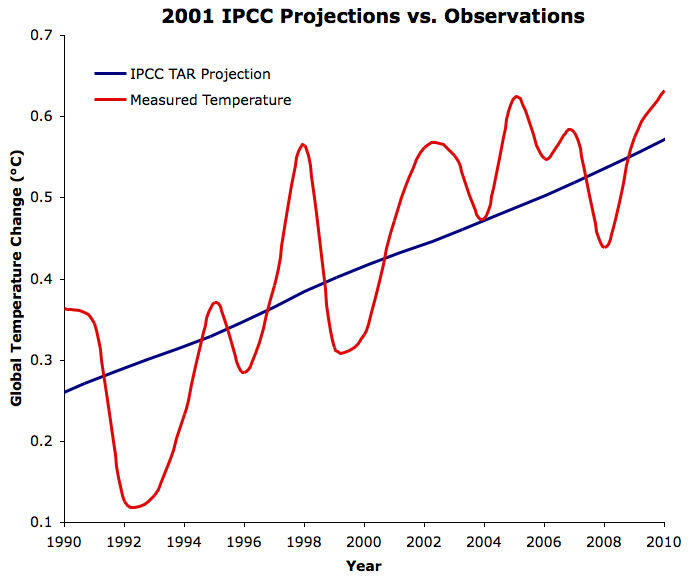ScienceRocks
Democrat all the way!
- Banned
- #1
Lessons from Past Climate Predictions: IPCC TAR
Lessons from Past Climate Predictions: IPCC TAR
Posted on 10 September 2011 by dana1981
The Intergovernmental Panel on Climate Change (IPCC) Third Assessment Report (TAR) was published in 2001, following the First Assessment Report (FAR) in 1990, and the Second Assessment Report (SAR) in 1995. Chapter 9 of the TAR discusses the report's projections of future climate change.
"A few Atmosphere-Ocean General Circulation Model (AOGCM) simulations include the effects of ozone and/or indirect effects of aerosols (see Table 9.1 for details). Most integrations do not include the less dominant or less well understood forcings such as land-use changes, mineral dust, black carbon, etc. (see Chapter 6). No AOGCM simulations include estimates of future changes in solar forcing or in volcanic aerosol concentrations.
There are many more AOGCM projections of future climate available than was the case for the IPCC Second Assessment Report"
As noted in our analysis of the IPCC SAR, the TAR reduced the projections of aerosol emissions and its associated (negative) radiative forcing in the second half of the 21st Century. As a result, the net radiative forcing in the TAR emissions scenarios were larger than those in the SAR, which led to higher warming projections by 2100. The equilibrium climate sensitivity of climate models also evolved between the SAR's "best estimate" of 2.12°C for doubled CO2 (which we saw led to an underestimate of the observed warming) and TAR:

We can also evaluate the accuracy of the IPCC TAR projections by isolating the recent data (Figure 3).
Just for discussion sakes! Is these graphs accurate to IPCC predictions to what really occurred?
Lessons from Past Climate Predictions: IPCC TAR
Posted on 10 September 2011 by dana1981
The Intergovernmental Panel on Climate Change (IPCC) Third Assessment Report (TAR) was published in 2001, following the First Assessment Report (FAR) in 1990, and the Second Assessment Report (SAR) in 1995. Chapter 9 of the TAR discusses the report's projections of future climate change.
"A few Atmosphere-Ocean General Circulation Model (AOGCM) simulations include the effects of ozone and/or indirect effects of aerosols (see Table 9.1 for details). Most integrations do not include the less dominant or less well understood forcings such as land-use changes, mineral dust, black carbon, etc. (see Chapter 6). No AOGCM simulations include estimates of future changes in solar forcing or in volcanic aerosol concentrations.
There are many more AOGCM projections of future climate available than was the case for the IPCC Second Assessment Report"
As noted in our analysis of the IPCC SAR, the TAR reduced the projections of aerosol emissions and its associated (negative) radiative forcing in the second half of the 21st Century. As a result, the net radiative forcing in the TAR emissions scenarios were larger than those in the SAR, which led to higher warming projections by 2100. The equilibrium climate sensitivity of climate models also evolved between the SAR's "best estimate" of 2.12°C for doubled CO2 (which we saw led to an underestimate of the observed warming) and TAR:

We can also evaluate the accuracy of the IPCC TAR projections by isolating the recent data (Figure 3).
Just for discussion sakes! Is these graphs accurate to IPCC predictions to what really occurred?
